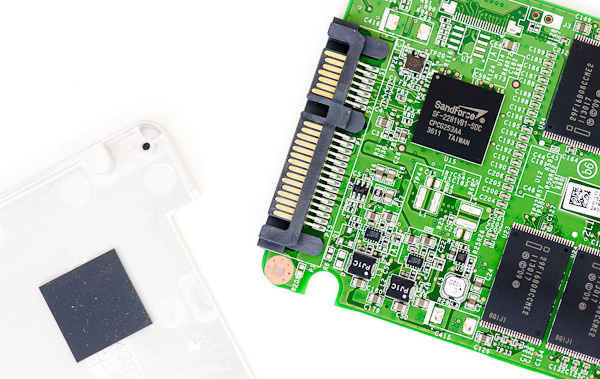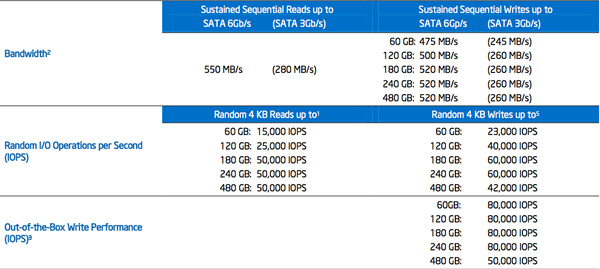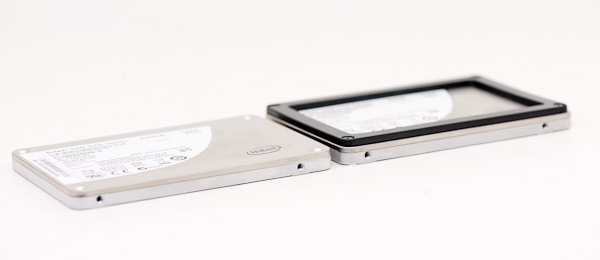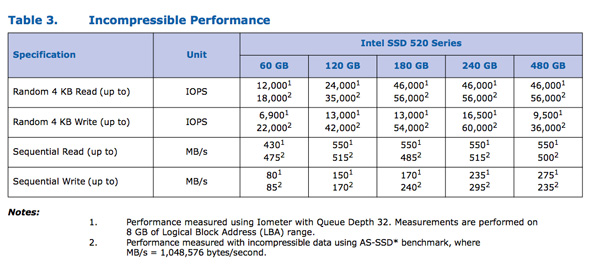Intel SSD 520 Review: Cherryville Brings Reliability to SandForce
by Anand Lal Shimpi on February 6, 2012 11:00 AM ESTThe Intel SSD 520
Intel sent us a 240GB and 60GB SSD 520 for review, but the performance specs of the entire family are in the table below:
The Intel SSD 520 is available in both 9.5mm and 7mm versions, with the exception of the 480GB flavor that only comes in a 9.5mm chassis. The 520's uses Intel's standard 7mm chassis with a 2.5mm removable plastic adapter that we've seen since the X25-M G2. The plastic adapter allows the drive to fit in bays designed for 9.5mm drives. Note that Intel doesn't ship shorter screws with the 9.5mm drives so you can't just remove the plastic adapter and re-use the existing screws if your system only accepts a 7mm drive.
Inside the drive we see the oh-so-familiar SandForce SF-2281 controller and Intel 25nm MLC NAND. The controller revision appears unchanged from other SF drives we've seen over the past year. The PCB design is unique to the 520, making it and the custom Intel firmware the two noticeable differences between this and other SF-2281 drives.

Intel uses the metal drive chassis as a heatsink for the SF-2281 controller
The SF-2281 Controller
I've explained how the SF-2281 works in the past, but for those of you who aren't familiar with the technology I'll provide a quick recap. Tracking the location of data written to an SSD ends up being one of the most difficult things a controller has to do. There are a number of requirements that must be met. Data can't be written to the same NAND cells too frequently and it should be spread out across as many different NAND die as possible (to improve performance). For large sequential transfers, meeting these (and other) requirements isn't difficult. Problems arise when you've got short bursts of random data that can't be combined. The end result is leaving the drive in a highly fragmented state that is suboptimal for achieving good performance.
You can get around the issue of tracking tons of data by simply not allowing small groups of data to be written. Track data at the block level, always requiring large writes, and your controller has a much easier job. Unfortunately block mapping results in very poor small file random write performance as we've seen in earlier architectures so this approach isn't very useful for anything outside of CF/SD cards for use in cameras.
A controller can rise to the challenge by having large amounts of cache (on-die and externally) to help deal with managing huge NAND mapping tables. Combine tons of fast storage with a fast controller and intelligent firmware and you've got a good chance of building a high performance SSD.

SandForce's solution leverages the work smart not hard philosophy. SF controllers reduce the amount of data that has to be tracked on NAND by compressing any data the host asks to write to the drive. From the host's perspective, the drive wrote everything that was asked of it, but from the SSD's perspective only the simplest representation of the data is stored on the drive. Running real-time compression/de-duplication algorithms in hardware isn't very difficult and the result is great performance for a majority of workloads (you can't really write faster than a controller that doesn't actually write all of the data to NAND). The only limit to SandForce's technology is that any data that can't be compressed (highly random bits or data that's already compressed) isn't written nearly as quickly.
Intel does a great job of spelling out the differences in performance depending on the type of data you write to the SSD 520, but it's something that customers of previous Intel SSDs haven't had to worry about. Most client users stand to benefit from SandForce's technology and it's actually very exciting for a lot of enterprise workloads as well, but you do need to pay attention to what you're going to be doing with the drive before deciding on it.
The Intel SSD Toolbox
The Intel SSD 520 works flawlessly with the latest version of Intel's SSD Toolbox. The toolbox allows you to secure erase the drive from within Windows, and it also allows you to perform firmware updates and pull SMART info from the drive. Unlike other SandForce toolboxes, Intel's software works fine with Intel's RST drivers installed.

The Test
| CPU | Intel Core i7 2600K running at 3.4GHz (Turbo & EIST Disabled) - for AT SB 2011, AS SSD & ATTO |
| Motherboard: | Intel DH67BL Motherboard |
| Chipset: | Intel H67 |
| Chipset Drivers: | Intel 9.1.1.1015 + Intel RST 10.2 |
| Memory: | Corsair Vengeance DDR3-1333 2 x 2GB (7-7-7-20) |
| Video Card: | eVGA GeForce GTX 285 |
| Video Drivers: | NVIDIA ForceWare 190.38 64-bit |
| Desktop Resolution: | 1920 x 1200 |
| OS: | Windows 7 x64 |























138 Comments
View All Comments
km23 - Monday, February 6, 2012 - link
What drive would you suggest for a Mac Pro? I have an early 2008 with 3G connection. I keep reading about the Mercury drives from Macsales. Any suggestions? Thanks.Beenthere - Monday, February 6, 2012 - link
WAIT for SSD makers to sort the Bugs out of their SSDs. Contrary to what Intel says, I think that's the only way we will have any idea of the reliability of the 520 series SSDs. Maybe in 12 months enough guinea pigs will have found most of the Bugs.troystarr - Tuesday, February 7, 2012 - link
I understand why IOPS would go down for smaller capacity drives with fewer NAND die to interleave, but I'm curious why it would go down when the capacity goes up.haa - Tuesday, February 7, 2012 - link
When using SSDs in laptops whole disk encryption is often required (and easy to enable with e.g. FileVault 2 on Macs) so it is not just a corner case as the computer is writing incompressible (encrypted) data all the time, bringing out the worst case performance case probably pretty soon...Cow86 - Tuesday, February 7, 2012 - link
So now that the belated 520 has finally shown up (originally Q4 according to the roadmap), will the other SSD that also should've been out already also show up soon? The successor to the intel 311, hawley creek? Kinda been waiting for that one for a reliable, and hopefully cheaper, caching SSD....Enough capacity means getting 180GB or more, which is too expensive from any vendor at this time for me, and I'm not too sure about using a 60 GB SSD for caching either, with regards to reliability....Hawley Creek seems to have completely dissapeared off the radar though :/fausto412 - Tuesday, February 7, 2012 - link
these things still have reliability issues?Westyfield2 - Tuesday, February 7, 2012 - link
Intel say:"Superior data protection features: The new Intel SSD 520 Series offers the best security features of any Intel SSD to date and comes preconfigured with Intel® Advanced Encryption Standard New Instructions (Intel® AES-NI) 256-bit encryption capabilities. In the event of theft or loss of your computer, you have the peace of mind that your personal data is secured by an advanced encryption technology. Additionally, the Intel SSD 520 Series contains “End-to-End Data Protection” ensuring integrity of stored data from the computer to the SSD and back."
Any details Anand? Here's a forum thread about FDE on the Intel 320. http://communities.intel.com/thread/20537?tstart=0
I, for one, would be very interested in an FDE SSD (I remember Samsung did one a few years ago, but that's all gone quiet).
panthal - Tuesday, February 7, 2012 - link
I find it odd Anand or anyone else doesn't think what Intel as has done is shady as hell.All the issues were not with the Sandforce controller.It was also partly how the Intel chip-sets handled power schemes and other advanced parts of the power management.Intel one was one of the MAIN vendors pushing for some of the more advanced power settings,then DISABLED them on their own Intel branded SSD drives.What does that tell you?The Sandforce fixes didn't come because Intel didn't want them sorted till it got closer to time for their own Intel branded Sandforce drives.They helped just enough to get the last firmware pushed that solved most the Sandforce issues.
Call it conspiracy if you want,but it's all there if you care to look.
Beenthere - Tuesday, February 7, 2012 - link
Perish the thought that Intel would ever operate in any manner than with the utmost integrity and respect for it's customers and the PC industry.http://www.theinquirer.net/inquirer/news/2120866/i...
NitroWare - Wednesday, February 8, 2012 - link
Some of the SATA power management schemes were convinced years ago before cheap SSDs became mainstream. Intel did not invent SATA by itself.No logic is perfect, even from Intel.
As for claiming Intel has somehow thrown a wrench into the gears thats a bit foolish. Corsair, OCZ and Kingston amongst others put their reputations on the line when these issues arise. These firms do not sell $300-$2000 CPUs that make up their revenue. For some tech firms, a product recall is the last thing they will ever want to do.
Apparently these cheap SATA III SandForce SSDs are selling like hotcakes in some regions from what some channel distributors tell me and they can't keep enough stock to meet demand or the vendors have to shift stock allocations between regions to meet such demands, annoying other regions.
Consumers want cheap SSDs, regardless of who they are from. No consumer will buy an ultra enterprise product for $2000. You can not have your cake and eat it too.
If there is a genuine issue with a product, either a fix will be made available or worst case swap under warranty for a revised product.
For specific motherboard support blame the mobo vendors. They are reluctant to patch BIOSes for older models such as adding the latest Intel Option ROM. Many angles to this. Manpower, validation, lazy, no care factor, pushing newer models, open a can of worms and so on. They can get the latest drivers, firmwares or fixes if they want, if they still buy particular chips they are provided with support. If they don't use this support its their fault.
Some are even reluctant to patch new boards.